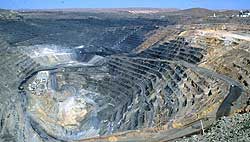Framework for Responsible Mining:
A Guide to Evolving Standards
 Barrick Goldstrike pit, Nevada. |
The Framework explores state-of-the-art social and environmental improvements, providing recommendations for -
- governments and government agencies;
- civil society groups, including NGOs;
- the mining industry;
- financial institutions, including public and private banks as well as insurers; and,
- retailers and other companies seeking to source or invest responsibly.
The Framework addresses issues related primarily to hard-rock mining (base and precious metals and gemstones). Although coal mining presents some of the same environmental and social challenges as hard-rock mining, it is also associated with additional problems (e.g., climate change) which fell beyond the scope of this research effort. However, some issues outlined in the discussions on no-go zones, social issues, and governance are broadly relevant to all extractive industries and even to many major development projects (e.g., dam construction).
This report is a working document intended to be used as expert guidance and to catalyze further debate and discussion among stakeholders interested in improving mining standards. As such, it aims to provide a well-researched and thoughtful analysis of the key issues that should be addressed when defining "responsible mining." It is important to note that this paper does not represent the views or positions of any specific company, NGO or civil society group. The Framework document is a first draft, open to debate and discussion; the authors encourage feedback and hope that the Framework can be improved with stakeholder input.